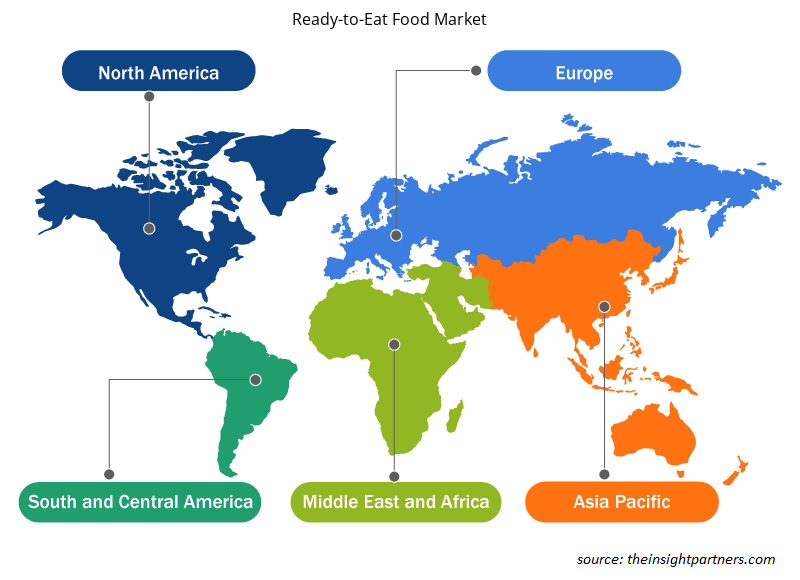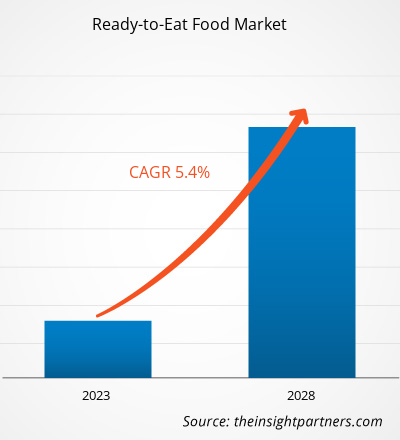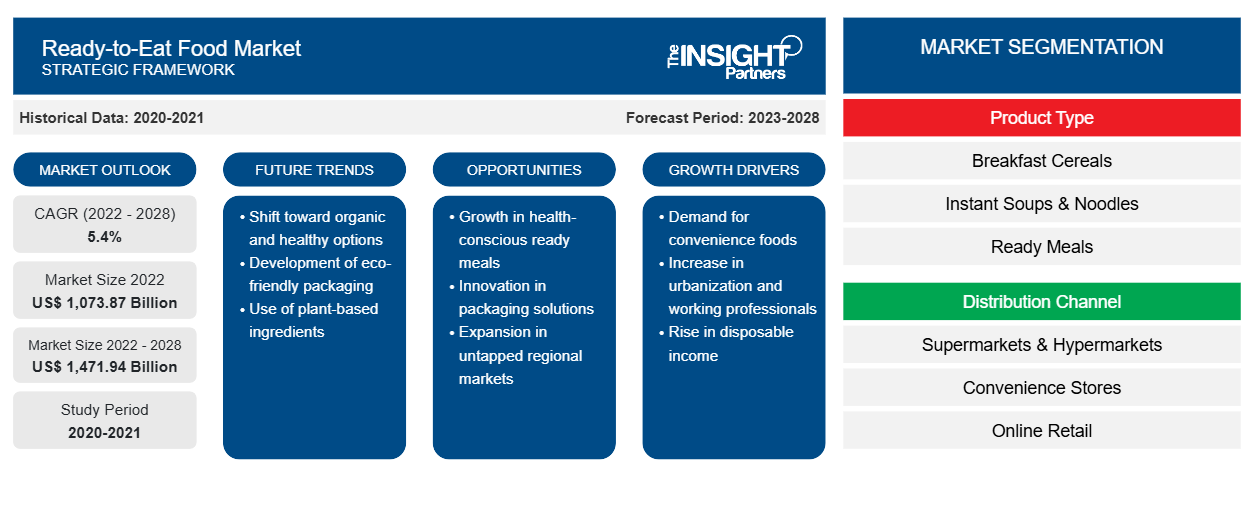[調査レポート] 調理済み食品市場は、2022年の1兆738億7000万米ドルから2028年には1兆4719億4000万米ドルに達すると予測されています。2022年から2028年にかけて5.4%のCAGRで成長すると予想されています。
調理済み食品は、追加の準備なしで食べられるさまざまな加工食品や包装食品で構成されています。原材料は洗浄、調理、加工され、直接食べられるよう容器に詰められます。RTE 食品の一般的なタイプには、インスタント スープ、焼き菓子、デザート、調理済み食品などがあります。これらの製品には、さまざまな抽出物、酸、香料、甘味料、抗酸化物質、保存料が豊富に含まれています。これらは消費者に非常に便利であると同時に、食事の準備時間を短縮し、製品の保存期間を延ばし、コスト効率を高め、腐敗を最小限に抑えます。
2020年、アジア太平洋地域は調理済み食品市場で最大のシェアを占めましたが、中東やアフリカなどの他の発展途上地域も予測期間中に大幅に成長すると予想されています。調理済み食品市場で活動する主要企業は、発展途上国の労働人口の増加と人々の多忙なライフスタイルにより、アジア太平洋地域全体で事業を拡大しています。個人は、外出先や自宅外での食事を選択することが増えています。
さらに、多くの研究により、多国籍食品飲料企業 (TFBC) が食品システムと一般消費に影響を与え、加工食品の入手可能性、望ましさ、価格、そして最終的には消費を変えてきたことが明らかになっています。中所得国では、調理済み食品市場の成長が顕著に見られます。
要件に合わせてレポートをカスタマイズする
このレポートの一部、国レベルの分析、Excelデータパックなど、あらゆるレポートを無料でカスタマイズできます。また、スタートアップや大学向けのお得なオファーや割引もご利用いただけます。
-
このレポートの主要な市場動向を入手してください。この無料サンプルには、市場動向から見積もりや予測に至るまでのデータ分析が含まれます。
COVID-19パンデミックが調理済み食品市場に与える影響
COVID-19パンデミックは、2020年初頭に多くの分野に前例のない課題をもたらしました。WHOと各国保健省のガイドラインに従って政府が実施したロックダウン、国境規制、渡航禁止、製造中止、その他の安全対策により、製造業務が妨げられました。一方、COVID-19の発生は、消費者と小売業者が陳列棚の長いインスタント食品を買いだめしていたため、調理済み食品市場にはプラスの影響を与えました。また、免疫力を高めるためにより健康的な包装食品や飲料製品を求める消費者は、COVID-19の影響に警戒していました。その後、RTE製品メーカーは、タンパク質やその他の栄養価を強化した健康的で栄養価の高い製品に焦点を合わせ、パンデミック中に調理済み食品の需要を刺激しました。
市場洞察
ミレニアル世代のインスタント食品への強い嗜好が市場の成長を牽引
高品質のインスタント食品の消費が増加しており、これは現在、食品業界における最大のトレンドの 1 つです。RTE 製品などのインスタント食品により、消費者は食事の準備や調理、消費、食後の活動に関連する時間と労力を節約できます。この食品セグメントの発展の源には、数多くの社会的変化、特に小規模世帯の増加と世界中のミレニアル世代の人口の増加が含まれると言われています。ミレニアル世代は仕事が忙しいため、退屈な作業に時間を浪費するよりも効率的に時間を活用したいと考えています。彼らは利便性のためにお金を使う可能性が高くなります。そのため、焼き菓子、スナック、乳製品などの RTE 製品がますます好まれるようになり、すぐに食べられる食品市場をさらに牽引しています。
製品タイプの洞察
製品タイプに基づいて、調理済み食品市場は、朝食用シリアル、インスタントスープと麺、調理済み食事、スナック、焼き菓子と菓子、その他に分類されます。その他の調理済み食品セグメントは、予測期間中に最大のシェアを記録すると予測されています。その他のタイプには、乳製品、デザート、スプレッド、ソース、ディップなどがあります。RTE乳製品には、アイスクリーム、ヨーグルト、パッケージ入りフレーバーミルク、チーズなどがあります。健康志向の消費者は、通常の乳製品が骨と腸の健康を改善し、心血管疾患(CVD)と2型糖尿病のリスクを軽減するため、主に乳製品を消費します。人々が伝統的な生活様式から現代的なライフスタイルに切り替えたため、加工およびパッケージ化されたソースとディップの人気が高まり、調理済み食品市場の成長を後押ししました。
調理済み食品市場の地域別分析
予測期間を通じて調理済み食品市場に影響を与える地域的な傾向と要因は、Insight Partners のアナリストによって徹底的に説明されています。このセクションでは、北米、ヨーロッパ、アジア太平洋、中東、アフリカ、南米、中米にわたる調理済み食品市場のセグメントと地理についても説明します。

- 調理済み食品市場の地域別データを入手
調理済み食品市場レポートの範囲
| レポート属性 | 詳細 |
|---|---|
| 2022年の市場規模 | 1兆738億7000万米ドル |
| 2028年までの市場規模 | 1兆4,719億4,000万米ドル |
| 世界のCAGR(2022年 - 2028年) | 5.4% |
| 履歴データ | 2020-2021 |
| 予測期間 | 2023-2028 |
| 対象セグメント |
製品タイプ別
|
| 対象地域と国 |
北米
|
| 市場リーダーと主要企業プロフィール |
|
調理済み食品市場のプレーヤー密度:ビジネスダイナミクスへの影響を理解する
調理済み食品市場は、消費者の嗜好の変化、技術の進歩、製品の利点に対する認識の高まりなどの要因により、エンドユーザーの需要が高まり、急速に成長しています。需要が高まるにつれて、企業は提供品を拡大し、消費者のニーズを満たすために革新し、新たなトレンドを活用し、市場の成長をさらに促進しています。
市場プレーヤー密度とは、特定の市場または業界内で活動している企業または会社の分布を指します。これは、特定の市場スペースに、その規模または総市場価値と比較して、どれだけの競合相手 (市場プレーヤー) が存在するかを示します。
調理済み食品市場で事業を展開している主要企業は次のとおりです。
- ネスレSA
- コナグラブランズ株式会社
- クラフト・ハインツ社
- ゼネラルミルズ社
- キャンベルスープカンパニー
免責事項:上記の企業は、特定の順序でランク付けされていません。

- 調理済み食品市場のトップキープレーヤーの概要を入手
流通チャネルの洞察
流通チャネルに基づいて、調理済み食品市場はスーパーマーケットとハイパーマーケット、コンビニエンスストア、オンライン小売、その他に分類されています。オンライン小売セグメントは、予測期間中に調理済み食品市場で最高のCAGRを記録すると予測されています。オンライン小売は、ユーザーに便利なショッピング体験を提供し、製品の配送が簡素化されます。オンライン小売店は、幅広い製品を大幅な割引価格で提供しています。また、消費者は希望する製品を遠隔地から便利に購入できます。
調理済み食品市場で事業を展開している主要企業は、ネスレ SA、コナグラ ブランズ社、クラフト ハインツ社、ゼネラル ミルズ社、キャンベル スープ社、MTR フーズ社、ホーメル フーズ社、タイソン フーズ社、JBS SA、ケロッグ社です。これらの企業は、新たな消費者トレンドに対応し、規制の枠組みを遵守するために、健康リスクの少ない製品の開発に取り組んでいます。また、合併や買収、事業拡大、提携に携わり、市場シェアを拡大しています。
レポートの注目点
- 即席食品市場における進歩的な業界動向は、プレーヤーが効果的な長期戦略を策定する上で役立ちます。
- 先進国市場と発展途上国市場での成長を確保するために採用された事業成長戦略
- 2019年から2028年までの調理済み食品市場の定量分析
- 調理済み食品の世界需要の推定
- 業界で活動するバイヤーとサプライヤーの有効性を示すポーターの5つの力の分析
- 競争市場の状況を理解するための最近の動向
- 市場動向と見通し、そしてインスタント食品市場の成長を左右する要因
- 商業的利益の基盤となる市場戦略を強調し、市場の成長につながる意思決定プロセスを支援する
- さまざまなノードにおける調理済み食品市場の規模
- 市場の詳細な概要とセグメンテーション、およびRTE製品業界の動向
- 有望な成長機会のあるさまざまな地域の成長規模
- 過去2年間の分析、基準年、CAGRによる予測(7年間)
- PEST分析とSWOT分析
- 市場規模価値/数量 - 世界、地域、国
- 業界と競争環境
- Excel データセット
最新レポート
関連レポート
お客様の声
購入理由
- 情報に基づいた意思決定
- 市場動向の理解
- 競合分析
- 顧客インサイト
- 市場予測
- リスク軽減
- 戦略計画
- 投資の正当性
- 新興市場の特定
- マーケティング戦略の強化
- 業務効率の向上
- 規制動向への対応























 無料サンプルを入手 - インスタント食品市場
無料サンプルを入手 - インスタント食品市場